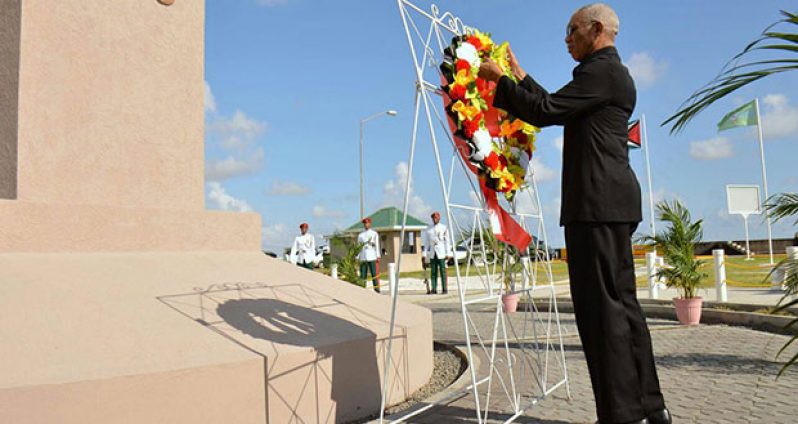-President says freedom was bought at a high price
FREEDOM from the horrific episode of slavery in British Guiana was bought at a high price – the martyrdom of hundreds of Africans – and the government will set up a monument at Independence Park (Parade Ground) to remind Guyanese of this chapter in history. This was announced by President David Granger on Saturday morning at the 1823 Demerara Revolt Monument at Atlantic Avenue on the Seawall. The early-morning event was the

commemoration ceremony of the 193rd Anniversary of the 1823 Demerara Revolt.
The seawall monument was commissioned in August, 2013, but prominent African groups had favoured Parade Ground as the most suitable location for a monument.
The Demerara Revolt is remembered in the village of Bachelors’ Adventure, where the massacre occurred. In this village, a memorial to remember the Demerara Martyrs was built by the residents.
However, President David Granger, during his address, said the government will erect a memorial at Independence Park (Parade Ground) to commemorate the executions during the 1823 revolt.
The intention of erecting this monument, the President said, was to remind Guyanese of the price paid for freedom.
“Future generations must not forget that freedom was bought at the high price of the martyrdom of hundreds of Africans on 20th August, 1823,” he said.
According to the Head-of-State, this “atrocity” is perhaps the single most significant event that hastened the abolition of slavery in the British colonies during that time. He noted that the Demerara Revolt was the turning point in slave society and is commemorated as one of the most important events in Guyanese and Caribbean history.
“The Revolt’s historical role in the passage of the Emancipation Act by the British Parliament in 1833, a decade later, is undisputed.”
The Demerara Revolt broke out on Monday, 18th August, 1823. Brigadier General John Murray, the Governor, proclaimed martial law the next day and mobilised a formidable military force. The massacre took place at Plantation Bachelors’ Adventure, where over 2,000 rebels confronted the main body of troops under Lieutenant Colonel John Thomas Leahy.
President Granger then went on to reference one account which stated that, “The soldiers poured in volley after volley. The slaves returned fire but soon began to run, leaping the trenches into which many tumbled lifeless. Many were shot down on the road and in the cotton fields. By noon, the roadside was littered with dead bodies. About two hundred slaves had been killed.”
He went on to explain that the troops triumphantly moved from plantation to plantation, pursuing fugitives and releasing the planters who, for the most part, were unharmed. They had been placed in stocks to prevent them from obstructing the freedom, which the Africans believed that King George had granted them.
However, he noted that retribution was swift and severe.
History records that Colonel Leahy and his officers held summary “drum-head” trials, each lasting only a few minutes. The courts reached hasty verdicts based on hearsay evidence, and according to him, the accused, invariably, were found guilty, tied to trees and shot, immediately.
Their corpses, the president said, were laid side by side on the ground, decapitated and their heads placed on poles on the public roads in front of the plantations.
On August 25, the formal Court Martial was convened in Georgetown under Lieutenant Colonel Stephen Arthur Goodman. The Militia Parade Ground (now Independence Park) in Cummingsburg was the scene of the public executions. Here, President Granger said, the rebels’ corpses were hung in chains along the public roads or were decapitated and the heads stuck on poles, after the hangings.
In addition, expeditions scoured the backlands in search of fugitive rebels, particularly, the assumed ringleader, Quamina. He was found by a mercenary who shot him dead on September 16 and his body was carried back and hung in chains outside Plantation Success on the East Coast.
The President, also a historian, further pointed out that the planters and populace were exultant. He said that the very excesses for which the planters congratulated themselves in Georgetown were condemned in London.
“The Demerara Revolt caused an uproar in the British House of Commons and, although a vote to censure the Government failed, public opinion shifted further in favour of the complete abolition of slavery” he said.
Subsequently, Brigadier- General John Murray was recalled and replaced as Governor by Major-General Sir Benjamin D’Urban in April 1824. The Emancipation Act was then passed a decade later.
Against this eventful, but horrific backdrop, the Head-of-State underscored the need for Guyanese to remember the price paid for freedom by the Africans.
Preceding the President’s featured address was the traditional practice of wreath-laying. The ceremony was punctuated with cultural items, including a dance by the National School of Dance and a melodious rendition of a national song. The short ceremony was attended by Government Ministers, Speaker of the National Assembly Dr Barton Scotland and other officials.




.png)









